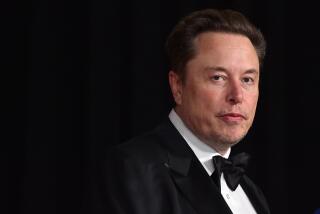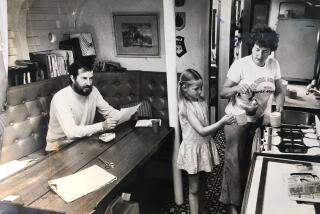No Mess, No Calories. . .the Beauty of Vicarious Cooking
“Ican’t tell you how many people come up to me after a talk and confide that they read cookbooks like novels,” says Barbara Haber, curator of books at the Schlesinger Library in Cambridge, Mass., which is known for its culinary collection.
These people don’t cook. Instead of cooking, they read about it. “In some cases,” says Haber, “it’s instead of eating.”
This is the day of the Virtual Gourmet. Finally, we have zero-calorie cooking, truly no-fuss entertaining, and the popularity of these fantasies says a lot about people, cookbooks and life today.
Whatever they do with them, people are buying more cookbooks. Purchases were up 35% in 1993, according to the most recent statistics available from the New York-based Assn. of American Publishers, though the category still represents only 7% of nonfiction books bought.
The Virtual Gourmets have a telltale number of these cookbooks, not just in the kitchen but the den, the living room, the bedroom.
Cookbooks are also “the perfect bathroom reading,” confesses one addict, “short but not too short, and if you can’t finish a chapter it doesn’t matter.”
Some of these readers even cook, or could cook, but cook less now than when they first started buying cookbooks.
“Nobody buys their first cookbooks as a reading experience,” says Los Angeles lawyer Ann Gold, whose cookbooks, organized by food, style or region, run from full multivolume series to individual books on risotto or squid. “But at some point, you cross over into the land of vicarious cooking.”
Gold crossed over when she had children, because, “if you try anything experimental or different, someone always says, ‘Yuk, what’s this?’ ”
It’s not just children, says child mental-health specialist Barbara Trikonis. “Since I learned to cook,” she says, “I’ve collected cookbooks. I always intend to cook from them, but life gets in the way.”
*
The amount of vicarious cooking going on doesn’t surprise Burbank bookseller Janet Jarvits, who specializes in used and out-of-print cookbooks. After all, she says, “It’s the way we experience life these days, not just food. It has a lot to do with TV, where you watch all this action but don’t do it, experiencing a lot of stuff, but passively, while just sitting there.”
And what an experience it is. Thanks to a perfect convergence of supply and demand, today’s cookbooks can send the Virtual Gourmet on a real trip.
Forget the trusty all-print manuals of yesteryear, the serious two-volume gourmet sets of 25 years ago, “with maybe one section of photographs in the middle,” says Gold. “Now you have coffee table cookbooks, like this ‘California the Beautiful Cookbook,’ $50. Do you think this book is made to cook out of? Do you see food stains on mine?”
These books are beyond simple pictures, and the food pictured isn’t yummy; it’s gorgeous. “They’re beautiful books,” says Haber. “With beautiful photos--still-life-with-food, or landscape-with-food.”
In fact, they’re beyond food, emphasizing instead the whole environment of food, its preparation and its presentation. Jarvits attributes this focus to Martha Stewart, whose first book, “Entertaining” (Crown), came out in 1983, and who was among the first to use a lot of photos of food served at table, usually in an elegant setting.
Sitting down with these books “is like reading travel literature,” says Trikonis. “You have the experience of being there, you get the taste and the elegance of the look, but you don’t have to bother cooking it or eating.”
Much of vicarious cooking is also travel, as cookbooks move away from the table--even Martha Stewart’s table--and into what cookbook publisher Anne Dickerson calls “the culture that surrounds food.” Dickerson is associate publisher at Weldon Owen, the San Francisco company that produces the “Beautiful Cookbook” series--lavish oversize books that run from “China the Beautiful Cookbook” through Asia, Europe, Mexico and several regions of the United States. (Coming this year: “Texas the Beautiful.”)
The focus on where food is from isn’t entirely unique. Time-Life Books had a successful series “Foods of the World” in the late 1960s. But for a reader, there’s a big difference between being mildly interested in a half-page shot of farmers loading cabbages into a wagon and jumping, daydreams first, into a full-color spread of formal gardens on an 11th-Century Tuscany estate, drawn by a platter of stuffed pigeon alfresco.
These are no how-to texts but gift books begging for deep chairs and warm lamplight. They do give the reader some fairly basic recipes for indigenous food, but more important, they provide “a window to that place,” says Dickerson, “and a feeling for it.”
It needn’t be another country. The point is the transport, and the Virtual Gourmet has a variety of destinations.
*
For some, reading cookbooks is a trip back in time, personal rather than scholarly. Janet Jarvits “fell in love with old cookbooks” when another bookseller, unloading some of his inventory, offered her 40 boxes of them. “I was reminded how my grandma would teach me how to cook something.”
“It’s mean streets out there,” says Beverly Hills resident Frenda Franklin, who buys “most of the books that come out” and reads perhaps two a day. “I’ll get in bed and read about a creamy chocolate pudding, and in a way, it fills you up, bringing back a lot of happy memories. It’s a piece of my childhood, where I was safe.”
“I read cookbooks because I sort of visualize sitting down to a lovely meal with friends, with a tablecloth and silver and candlelight,” says antique dealer Marsha Carter. Although she does little cooking and less entertaining now, she says “you wouldn’t believe how many cookbooks I have. The last one I bought was on fancy breakfasts; wouldn’t that be wonderful? I buy gardening books, too, and my garden’s a wreck.”
The real secret of the Virtual Gourmet is that reading does indeed replace eating. “As I read,” says Gold, “I eat, I taste, I savor. Isn’t it nice to eat all these things we never eat, to taste all these things we might never get a chance to try? Have a little cream sauce. Have some more calories.”
Virtual reality can be quite satisfying. After a half-hour of reading recipes, vicariously separating eggs, chopping onions, beating out lumps, thickening sauces, you’re “just not hungry,” says Roark.
On the other hand, cookbook reading can lead one right back to cooking, a kind of therapeutic pornography for the tired housewife. When it’s getting toward supper time and she’s not that hungry, and doesn’t feel like making dinner, Gold will sometimes sit down with a cookbook to get in the mood.
Face it, she says. Reading a cookbook can also make you hungry.
More to Read
Sign up for our Book Club newsletter
Get the latest news, events and more from the Los Angeles Times Book Club, and help us get L.A. reading and talking.
You may occasionally receive promotional content from the Los Angeles Times.






